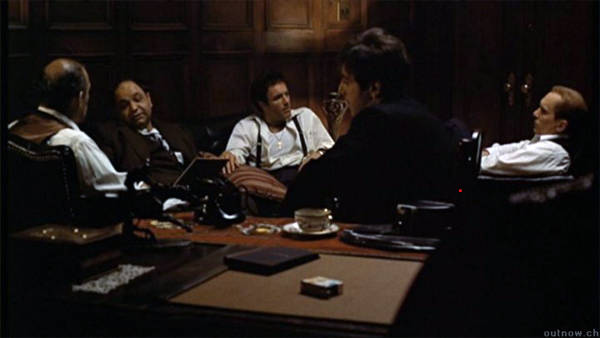Art vs. Reality: Why Italian Americans like “Mob Movies”
Recently, over at H-ItAm, there has been a discussion about the results of a survey of teenagers conducted by Zogby International and posted on the John D. Calandra website. The purpose of the survey was “to determine whether or not teenagers in general and Italian American teenagers in particular perceive stereotyping on television and in the movies and if they do, how such stereotyping affects them.” The results showed “teenagers perceived” that Italian American stereotypical media images were “crime boss, gang member, or restaurant worker.” Further, “when Italian American teens were asked if their ethnic heritage was accurately portrayed on television or in the movies, 46% agreed and nearly 30% said they were proud of their TV image.”
In response to this report, the usual lamentations about the negative affect of media on Italian Americans were posted. For example, one member wrote: “Fact is, as time goes by, the negative results from this survey will only increase.” Another, “Italian Americans who support the media's negative images of the IA ethnicity are our biggest enemies…”
For decades, we have periodically been told by one source or another that media images of Italian Americans are negative and in turn having a negative affect on Italian Americans. However, there is evidence to the contrary. For example, days before the Zogby discussion, there were postings on H-ItAm celebrating the increasing numbers of Italian American college graduates and numbers of Italian American doctors and lawyers. Also, one cannot ignore two Supreme Court Justices, the Speaker of the House of Representatives, a major Presidential candidate and numerous CEO’s of international corporations who are Italian Americans. In short, there is data suggesting that media images of Italian Americans are not having significant measurable negative affect on Italianita (Italian American culture).
One may wonder why the apparent contradiction: negative media images – no negative affect. It may be the case that Italian Americans are wise enough to ignore inaccurate media representations. However, there is evidence suggesting that Italian Americans are not ignoring media images; on the contrary, they embrace those images. Note, the Zogbe survey reports that almost half of the surveyed Italian American youth thought the media images “accurate[ly] portray their ethnic heritage and nearly 30% said they were proud of their TV image.” In short, a significant percentage of Italian American teens felt that what they see in the media is consistent with what they see in reality and liked what they saw. More generally, an H-ItAm commentator is not alone when suggesting that Italian Americans liked their media image. He wrote: “So many IA's have been the strongest patrons of shows like The Sopranos….”
In short, the case that movie/TV images are negatively impacting Italian American self image, while not to be ignored, is not conclusive. Indeed, if critiques of movie/TV shows would get beyond the criminality and make more comprehensive literary critiques of these dramas, they will find many positive literary qualities which may explain their popularity with Italian Americans.
Essentially and more generally, this issue of negative Italian American media images falls under the aegis of the perennial debate of ‘art vs. reality.’ That is: to what extent movie/TV dramas (art) distort the ‘reality’ of Italian American history and culture. This ‘art vs. reality’ issue has been pervasive throughout the history of Western Culture. For example, Plato argued that “poets and tragedians” should be barred from his ideal state ‘The Republic’ because they distort reality and mislead the populous. Similarly, in the early 19th century, Alessandro Manzoni’s, arguably the best indeed definitive historical novel, “I promessi sposi” gave rise to a great European debate that included Goethe about historical novels and historic reality. More recently, Lampedusa’s absolutely brilliant novel “Il gattopardo” was early on largely ignored in Italy because it was considered not realistic. And, today there is a great debate about the reality of the genera pejoratively characterized as “Mob Movies” (“The Godfather”, “The Sopranos”, etc).
To my mind, the concerns raised by mob movie critics are largely based on an oversimplified single facet of those dramas – i.e. the gangster image. Specifically: criminals are bad; therefore they represent an unrealistic negative image of Italian Americans. However, more comprehensive literary criticism of movies like “The Godfather” and televisions series like “The Sopranos” reveal literary qualities that may be the basis of their popularity with Italian Americans. To see only the criminal aspect of the characters in these dramas is to ignore the historical/cultural context of the crimes, and the complex inner-conflicted character of the criminal protagonist.
The Godfather trilogy, for example, clearly has the characteristic of Greek Tragedy (i.e. “…the downfall of a noble hero or heroine, usually through some combination of hubris, fate, and the will of the gods…”). The Michael Corleone character from the beginning of the first Godfather movie to the end of the third is continually trying to escape the criminal life. But, because of his hubris (i.e. excessive ambition) he cannot escape his self-destructive destiny. He says: “Every time I try to get out [of crime], I get pulled back in.” Finally, in the last scene of the trilogy he is seen “like Hecuba languished and alone” – the tragic protagonist who could not escape his destiny.
It is important to keep in mind that the concept of tragedy and destiny are integral to the southern Italian/Sicilian culture rooted in the Ancient Greek culture. Ancient theaters where Greek Tragedies were performed still exist in Sicily. Thus, where some see a negative image of a “Don” or “crime boss” to be scorned, others see an unyielding albeit self-destructive protagonist struggling against an inescapable fate. Those who are so offended by the brutal vengeful mob movie characters, like Michael having his brother killed and Tony Soprano’s mother plotting to have him killed, have never read the Oresteia or Media.
The ancient Greek-Italian progenitors of today’s Italian-Americans did not flock to the theaters in Syracuse, Taormine and Segesta by the tens of thousands simply to indulge themselves in the gore of Media killing her children or Orestes killing his mother. Rather, they were responding to a primordial subliminal cultural impetus - a “tragic sense of life” imbued with moral ambiguity, suffering and destiny. We should be open to the possibility that the Italian American progeny of those ancient Greek-Italians are responding to a similar if not the same cultural impetus.
The best of the mob literature (films and novels) manifest this same juxtaposition of suffering, destiny and moral ambiguity (“when is killing justified - Socrates”). They can be found in the “Godfather Trilogy”, “The Sopranos”; Alberto Lattuada’s “Mafioso”, Ben Morreale’s “A few virtuous men [Li cornuti], etc. Should the artists who create this literature be exiled from the Italian American “Republic” because they misrepresent our reality? Or, should they be studied that we might better understand our reality?
In sum: to understand why the ostensive negative images of Italian American reality are appreciated by Italian Americans requires a more comprehensive literary criticism and historical culture studies that get beyond the criminal behavior and articulates the artistic nuances which metaphorically captures the far more complex and profound Italianita reality. Only then will we understand why Italian Americans like “Mob Movies.”





































i-Italy
Facebook
Google+
This work may not be reproduced, in whole or in part, without prior written permission.
Questo lavoro non può essere riprodotto, in tutto o in parte, senza permesso scritto.